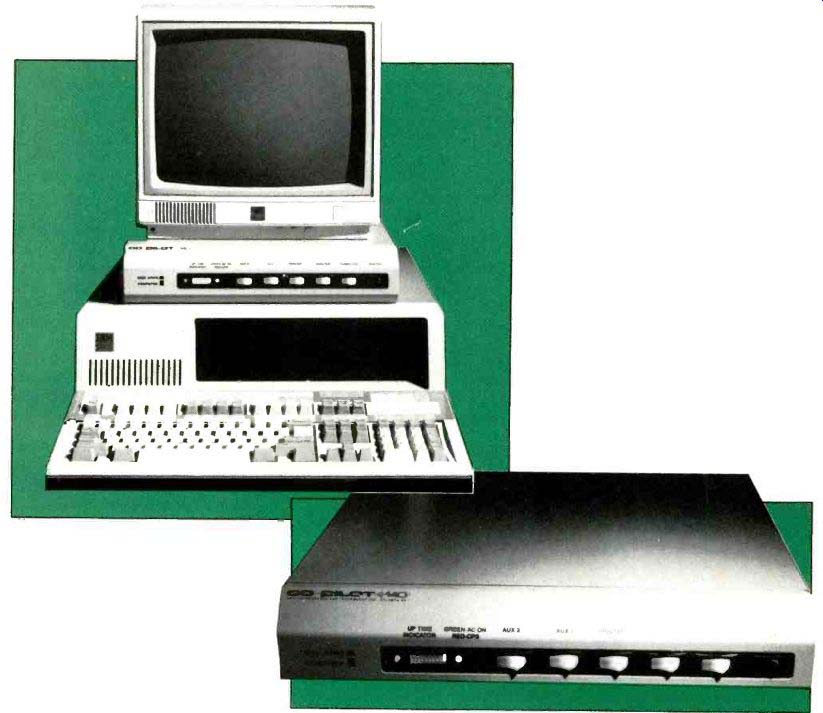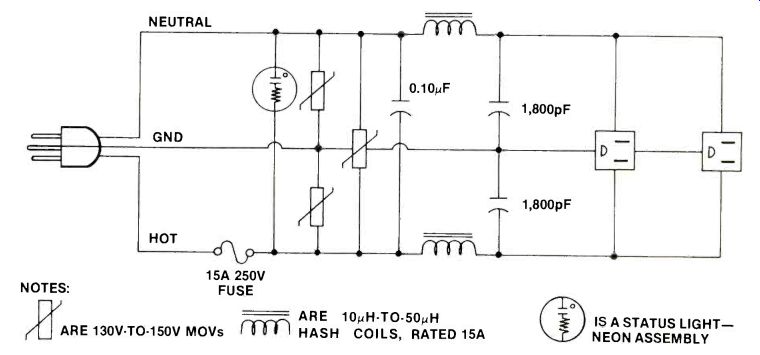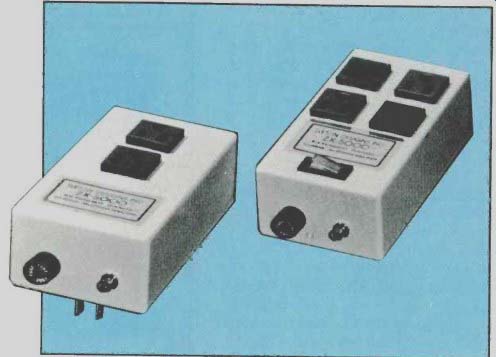By Conrad Persson
--------------------
AC CURRENT FROM STANDARD UPS--REQUIRES DC-AC AND AC-DC CONVERSION
CO-PILOT CPS SYSTEM
MONITOR SUPPORT 125Vac 50-60 Hz
COMPUTER POWER SUPPLY
INTERFACE CABLE "T" CONNECTOR SURGE/SPIKE SUPPRESSOR EMI/RFI
DISK DRIVES
AC POWER SUPPLY CIRCUIT BREAKER
----------------------
(Courtesy of Applied Research and Technology. Atlanta. GA.)

Late last winter, a relative asked me what I thought about the need for power conditioning. He had received a flyer from the local power company announcing a program of power conditioning for its customers. For a fee, the company would send an electrician to his house to install a lightning arrester, to protect the power line coming in, and a surge suppressor at the point where the most sensitive equipment is connected to the home's electrical wiring.
My response was that it's like buying insurance. His house might never be hit by lightning, making the investment worthless. On the other hand, if he didn't have it done and lightning hit the house, some equipment would be damaged.
About a month later he told me that the house had been hit by lightning, he had not had any of the power protection equipment installed, and the garage door opener, the TV and a cordless phone had been damaged.
Not long after that, a friend at work told me that her house had been hit by lightning and some of her consumer electronics equipment, notably her television, had been damaged.
These are, unquestionably, spectacular failures caused by disturbances on the power line. Whether or not it is economically feasible to protect the incoming power line of any one home against what is still an unlikely occurrence is still a moot point. However, it has been demonstrated that power lines inside and outside homes are subject to disturbances that can cause damage to delicate electronics equipment. The cumulative effect may be degradation of performance or outright failure of the product.
The nature of power-line disturbances
Much of the following information is excerpted from a paper titled "Power Line Problems -- An Introduction," by Charles F. Kerchner, Jr., P.E., President of Kalglo Electronics Company of Bethlehem, PA.
To understand what power-line disturbances are all about, you need to understand some terms and definitions.
Steady-state voltage--This term describes steady-state rms voltage values that stay constant for 10 seconds or longer.
Nominal or normal voltage--The normal, planned voltage for a system. For most purposes in con sumer electronics this is 110Vac to 125Vac.
Power failure--A condition in which the power-line voltage drops to zero for more than one cycle (1/60 of a second) on any one of the three phases used to transmit the power.
Blackout--A total power failure lasting from several seconds to hours or more.
Brownout--A reduction in the steady-state utility power-line voltage below its nominal value. The term brownout ordinarily means a low-voltage condition that is planned and announced beforehand to users, and is usually done to compensate for heavy electrical consumption.
Undervoltage--A continuous reduction in the steady-state voltage to below the nominal voltage. This condition is similar to brownout but ordinarily refers to unplanned reductions by the utility or a localized condition on a particular circuit.
Over-voltage--A situation where the steady-state voltage of the power line exceeds the nominal voltage.
Sag--A decrease in the powerline voltage for a number of cycles of the power waveform on any of the three phases. The duration of a sag is determined by the number of cycles of the 60Hz frequency that the disturbance lasts.
Dip--A brief decrease in the power-line voltage. This is similar to a sag, but lasts a shorter amount of time.
Surge--An increase in powerline voltage above normal that lasts for a number of cycles. A surge is the overvoltage equivalent of a sag.
Impulse--A very short-term disturbance, increase or decrease, superimposed on the ac sine wave, that typically lasts between 0.5µs and 100µs. Impulses that increase the instantaneous voltage are called spikes, while those that decrease the instantaneous voltage are called notches.
Spike--An overvoltage impulse ranging from 400V to 5,600V or more, superimposed onto the ac sine wave. Any spike of more than 600V can be highly damaging.
Notch--An undervoltage impulse similar to a spike, but of opposite polarity to the instantaneous value of the ac sine wave. It is called a notch because the effect is to cause a notch in the sine wave. A notch typically lasts about as long as does a spike, but it may last up to several milliseconds. Spikes and notches ordinarily occur in pairs or in an oscillating series. For every notch there is usually a spike that follows because of power-line inductances and capacitances.
Transient--Any short-term, abnormal event on the power line. All power-line disturbances are transient by definition.
EMI--An abbreviation for electromagnetic interference. In terms of power-line problems, this is broad spectrum, electromagnetic noise that is either impressed on the power line directly from the source, or is radiated to the power line and then conducted to susceptible equipment.
RFI--Electromagnetic noise in the radio frequency spectrum.
TVI--Electromagnetic noise in the television spectrum.
EMP--The abbreviation for electromagnetic pulse; E MP describes the powerful pulse of electromagnetic energy, generated by a thermonuclear explosion, that may damage or destroy sensitive electronic devices and interfere with electronic telecommunications.
Differential mode--Power-line disturbances that occur across the normal current-carrying wires of the power line, from the hot wire to the neutral.
Common mode--Power-line disturbances that occur between both of the current-carrying wires and ground.
MOV--The abbreviation of the term metal oxide varistor. This is a 2-terminal device with a voltage-dependent resistance: When the voltage across the device increases above a specified value, its resistance decreases abruptly (i1 ns to 5ns). When connected from a line to ground, for example, if a large transient occurs, it switches from a very large value of resistance (essentially an open circuit) to a very low value and absorbs the potentially damaging voltage increase.
MOVs are most effective when used in groups of three (line to ground, neutral to ground, line to neutral) to provide both common-mode and differential-mode protection.

-------- This unit, the Mini-II, plugs directly into any properly grounded
outlet, provides transient-voltage surge protection and is available with
EMI/RFI filtering. ------------
Silicon avalanche zener diodes--A fast-acting, solid-state junction device, but with low energy-handling capacity. With switching speeds in the picosecond range, they operate by shunting the surge or spike to ground before it can enter the protected circuit.
Gas discharge tube--A calibrated spark gap in a gas-filled chamber. These devices are relatively slow, operating in microseconds, but they can handle very large energy surges. They operate by shunting the surge or spike to ground before it reaches the protected unit. These devices are frequently placed at the service entrance and are used to provide protection for the wiring in an entire building.
EMI/RFI filter--A circuit or device that contains series-inductive (load-bearing) and parallel-capacitive (non-load bearing) components that provide a low-impedance path around the protected circuit for high-frequency noise.
Filters also attenuate impulses, because a Fourier analysis of a spike will reveal that a spike is composed of high-frequency sinusoidal components. Because of this, filters and surge suppressors used together act synergistically; that is, the two together provide better protection than the sum of the individual protection factors.

---- This unit, the Co-Pilot by Applied Research and Technology, is designed
to be placed directly on the computer. The computer monitor is then placed
on top of it. The unit provides surge and spike protection and EMI/RFI protection.
In addition, according to the manufacturer, its internal battery will provide
two hours of operating time for a fully loaded IBM PC AT in the event of a
blackout or brownout.
UPS--Abbreviation for uninterruptible power system. Provides a steady source of power at or near the nominal line voltage to a piece of equipment, regardless of powerline disturbances such as sags, dips, brownouts or blackouts.
Voltage-regulating transformer--A continuous acting transformer, usually ferroresonant, that instantaneously regulates the output voltage to normal levels despite wide swings in the input voltage.
Power-line conditioner--A combination of a voltage-regulating transformer with a super isolation transformer that provides smooth, regulated, noise-free ac voltage with no ohmic connection between input and output. This kind of unit will correct most power problems other than complete power failure.
How often do problems occur?
Mr. Kerchner's paper cites studies by three organizations that indicate that power-line problems occur regularly. For example, one study by members of the Institute of Electrical and Electronic Engineers (IEEE) shows that surges and impulse voltage spikes can occur as frequently as twice per hour in a typical residence, with peak values as high as 1,500V to 2,500V. During thunderstorms, peaks as high as 5,600V were observed.
A study by IBM in 29 different locations throughout the United States showed that an average of around 50 voltage spikes occur per month. This represented almost 40% of the total disturbances they observed.
A 2-year study by Bell Laboratories showed that most locations will experience approximately 25 power-line disturbances in a year, 87% of which were sags below 96V. Sags of this magnitude can cause the power supply in electronic equipment to malfunction.
While these studies don't agree completely on the nature of powerline disturbances, there is correlation that power-line disturbances are indeed a problem.
Solving the problem
Part of the solution is in the hands of the engineers who design the products. Where the quality of the product warrants, they must design or specify power supplies that will operate over a wider range of power-line voltages. They can include power-line disturbance suppression circuitry in the products they design.
For products that do not have adequate protection from powerline disturbances, which includes most if not all electronics products found in the average home (TVs, stereos, microwave ovens, VCRs, personal computers and so forth), the answer is to connect some kind of protection device in the power line to intercept spikes and surges before they enter the unit.
Mr. Kerchner makes an interesting point regarding external protection. Even in cases where internal protection is provided, it may make sense to use external protection. No matter how good a job the design engineer does of designing--in protection, those protection components usually take some finite, even if very short, time to turn on and provide their protection. And some kinds of faults can find their way around or through some kinds of power-line disturbance. If protection is provided external to the unit, the wiring between the protection device and the unit being protected provides a kind of delay line, giving the external protection device time to work fully before the disturbance reaches the equipment.
How power-protection devices work
Power protection comes in a number of shapes, sizes and degrees of effectiveness. One of the most familiar is the simple 6-outlet power strip with built-in components to intercept sags and spikes coming down the line before they get into your expensive and sensitive VCR or personal computer.
Other power-protection devices are simply plugged directly into the wall outlet. Sensitive electronic equipment is then plugged into the power protection device.
There are some power-protection devices that are made for specific brands of computers. These include delayed turn-on of some of the outlets so that the computer will be turned on before the peripherals, such as the printer or external disk drive. Some manufacturers even provide a current sensor on one of the outlets in the box, so that all of the other outlets remain inoperative until current is drawn from one main receptacle. This gives the user the ability to use the on/off switch of one piece of equipment plugged into the device as a master switch to turn on all the equipment plugged into the device at once.
The sidebar accompanying this article shows schematic diagrams of some of the kinds of power-line conditioning products available and describes how they work.
How good are they? Power line conditioning products available for consumer electronics range from the almost worthless to the very effective.
For starters, you can get some idea of the effectiveness of a given product by checking its UL listing.
A good guide is to check to see if the device carries a label that says that it is UL Listed under Classification 1449 or 1283. UL classification 1449 is the classification for transient-voltage surge protection, and this listing indicates that the device has been tested and found to provide this type of protection.
UL classification 1283 indicates that the device has been tested and shown to provide transient-voltage surge suppression and also provides RFI/EMI noise protection.
If a device is listed under some other classification, it might have only been tested and found to be safe under the standard for an extension outlet or multi-outlet plug, with no indication of whether it protects against transients.
------------

This device is designed to protect the entire building and all electric/electronic
equipment in it from large, high-voltage surges coming from outside the building.
Considered primarily a lightning surge arrester, this device would be installed
by an electrician at the service entrance. It consists of a gas tube that
dissipates larger surges to ground, then restores itself.
--------
Here is a schematic diagram of a transient-voltage protection device with EMI/RFI noise protection. When the neon lamp is lit, it merely means that the device is connected to the line. It doesn't imply that the protection components are working.
The three MOVs provide transient-voltage surge suppression, and the capacitors and coils provide EMI/RFI noise suppression. As discussed in the text, however, the transient protection and noise suppression act together synergistically so that the total protection offered by the combination is greater than the sum of the individual circuits.
The three MOVs are voltage-dependent resistors. The two MOVs connected from hot to ground and from neutral to ground protect against common-mode transients: those that are impressed on both the neutral and hot lines. The MOV connected from hot to neutral protects against differential-mode voltage transients.
Although the legend indicates that the MOVs used are rated between 130V and 150V, Kerchner says that 150V units are adequate to provide protection. Attempting to clamp the device's output too close to nominal line voltage might cause damage to the protection device in the event of a prolonged rise in line voltage to at or slightly above the rating of the MOVs.
The arrangement of capacitors and coils attenuates smaller-voltage anomalies that would not activate the MOVs, but would appear as noise at the input of the electronic product plugged into the line if they were not attenuated.

--------------------

According to the manufacturer, this unit, the Sutton Designs ZX-5000 Extended Range series of surge-spike-noise suppressors, contains advanced protection circuitry designed for computer protection in military, space and heavy-duty commercial applications. Voltage withstand capability of the units is 25,000V, the dynamic short-term current rating is 20,000A, and clamping voltage is 195V.
---------
I like to think transient-voltage surge suppressors are a little like seat belts: For the most part, you probably don't need one, but it's a good idea to have it on and working in case you ever do need it.
And just as with seat belts, they will protect you up to a point. If you drive head-on at 65 miles per hour into a semi going 65 miles an hour in the opposite direction, no seat belt is going to save you. Just so with power protection devices: If your VCR is plugged into the ac line when a lightning bolt strikes the power line a few feet from your house, the spike coming through will probably destroy any power protection device and the equipment it was installed to protect as well.
And if the unit it was designed to protect is your personal computer and you're sitting at the keyboard, you just might experience catastrophic failure as well.
Once again, caution is urged. If there are thunderstorms in the area, unplug any sensitive electronic products (do this well before the electrical activity gets too close, lest you have your hand on the plug when the surge comes down the line), and don't go near any wiring that comes into the house from outside: antenna, cable, telephone.
Which brings me to one final point: When you're thinking about transient-voltage surge suppressors, you might also give a thought to suppressors for the telephone line if there's a modern for the computer, and consider some kind of protection for any other wiring corning into the house from outside.
Also see:
Troubleshooting startup circuits